Drone technology is revolutionizing wildlife observation from above. You'll find that these unmanned aerial vehicles equipped with high-resolution cameras and thermal imaging sensors are transforming how researchers study animals in their natural habitats. Drones allow for rapid coverage of vast areas, access to remote locations, and minimal disturbance to wildlife. They're particularly useful for counting populations, tracking migrations, and monitoring endangered species. With AI-powered identification systems, drones can provide real-time data on animal movements and behaviors. As drone technology continues to advance, it's opening up new possibilities for conservation efforts and our understanding of ecosystems. Discover how this aerial revolution is reshaping wildlife research and protection.
The Rise of Drone Technology

Over the past decade, drone technology has revolutionized wildlife observation. You've likely seen these unmanned aerial vehicles buzzing overhead, but their impact on wildlife research is profound. Drones equipped with high-resolution cameras and thermal imaging sensors now allow you to observe animals in their natural habitats without disturbing them.
You'll find researchers using drones to count populations, track migrations, and monitor endangered species. They're particularly useful in hard-to-reach areas like dense forests or remote islands. With drones, you can cover vast territories quickly and efficiently, gathering data that was once impossible to obtain.
The technology's not just for professionals anymore. As a wildlife enthusiast, you can now purchase consumer-grade drones with impressive capabilities. You'll capture breathtaking footage of animals in their natural environments, all while maintaining a safe distance.
However, it's essential to use this technology responsibly. You must follow local regulations and respect wildlife. Drones can stress animals if used improperly, so always prioritize the well-being of the creatures you're observing.
With proper use, drone technology offers an unprecedented window into the animal kingdom, transforming how you experience and understand wildlife.
Advantages of Aerial Wildlife Monitoring
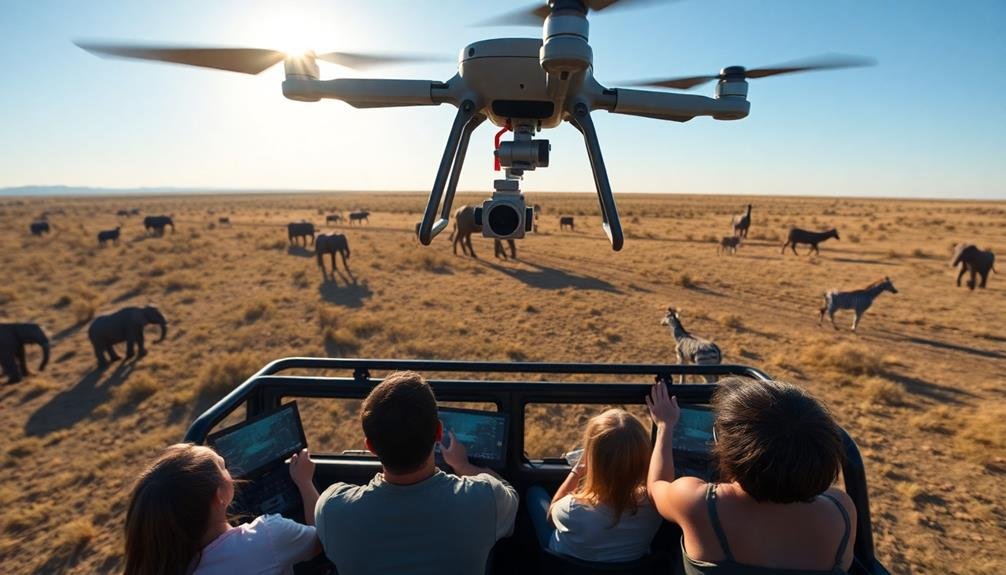
Aerial wildlife monitoring offers a bird's-eye view that's revolutionizing conservation efforts. You'll find that this approach provides numerous advantages over traditional ground-based methods.
First, it allows you to cover vast areas quickly and efficiently, reducing the time and resources needed for surveys. You can access remote or dangerous locations that would be challenging or impossible to reach on foot.
From above, you'll gain a thorough understanding of animal populations, their movements, and habitat use. This bird's-eye perspective helps you detect patterns and behaviors that might go unnoticed from the ground.
You'll also minimize disturbance to wildlife, as drones and aircraft can observe animals without direct human presence.
Aerial monitoring enables you to collect high-resolution imagery and data, which you can analyze in detail later. This approach is particularly useful for counting large herds, tracking migratory patterns, and evaluating habitat health.
You'll find it easier to monitor changes over time, helping you make informed conservation decisions.
Additionally, you can use thermal imaging to detect animals hidden by vegetation or darkness, enhancing your ability to conduct accurate population estimates and protect endangered species.
Types of Drones for Conservation

Conservationists have a range of drone options at their disposal for wildlife monitoring. You'll find fixed-wing drones, which excel at covering large areas efficiently, and multirotor drones, offering superior maneuverability for detailed observations. Each type has its strengths, suited to different conservation needs.
Here's a quick overview of common drone types used in wildlife research:
| Drone Type | Pros | Cons | Best Use Case |
|---|---|---|---|
| Fixed-wing | Long flight time, large area coverage | Limited hovering ability | Surveying vast habitats |
| Quadcopter | Highly maneuverable, stable hovering | Shorter flight time | Detailed close-up observations |
| Hexacopter | Increased stability, payload capacity | More expensive, complex | Carrying specialized sensors |
You'll need to take into account factors like flight time, payload capacity, and ease of use when selecting a drone for your conservation project. Fixed-wing drones are ideal for mapping large areas, while multirotor drones excel at capturing detailed imagery of specific animals or habitats. Some advanced models even incorporate thermal cameras or acoustic sensors for specialized monitoring tasks. By choosing the right drone, you'll enhance your ability to gather essential data for wildlife conservation efforts.
Thermal Imaging in Wildlife Detection
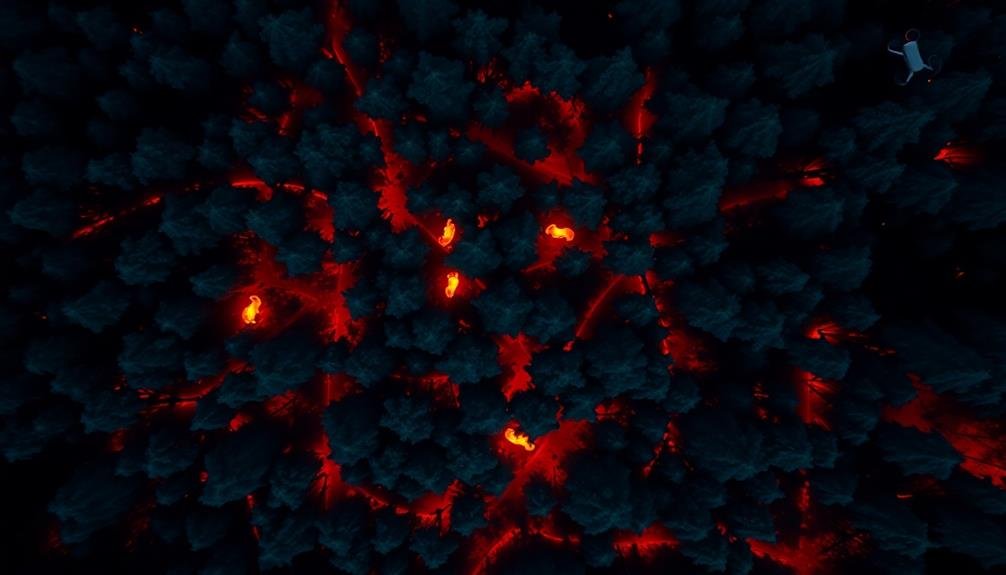
Thermal imaging has revolutionized wildlife detection in conservation efforts. You'll find this technology incredibly useful for spotting animals in dense vegetation, at night, or from great distances. Thermal cameras detect heat signatures, allowing you to see warm-blooded animals that might otherwise be invisible to the naked eye or traditional cameras.
When you're using thermal imaging for wildlife observation, you'll notice several advantages:
- It's non-invasive, causing minimal disturbance to animals.
- It works in complete darkness, expanding your observation hours.
- It can detect animals hidden behind foliage or camouflaged.
- It helps identify injured or sick animals by spotting unusual heat patterns.
You'll find thermal imaging particularly effective for population surveys, anti-poaching efforts, and monitoring endangered species. It's especially useful for nocturnal animals or those in hard-to-reach habitats. By attaching thermal cameras to drones, you can cover vast areas quickly and efficiently.
However, you should be aware of some limitations. Thermal imaging can't penetrate water or glass, and it may struggle to detect cold-blooded animals.
Despite these constraints, it remains a game-changing tool in wildlife conservation, offering unprecedented insights into animal behavior and population dynamics.
AI-Powered Animal Identification Systems
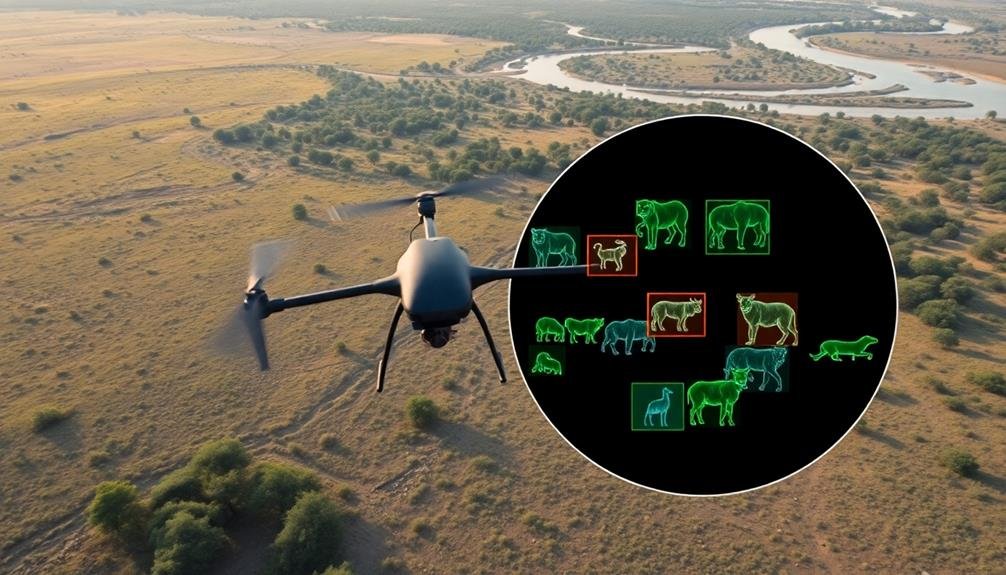
AI-powered animal identification systems are revolutionizing wildlife observation from above.
You'll find these systems employing automated species recognition algorithms to quickly and accurately identify animals in aerial imagery or video footage.
These cutting-edge tools enable real-time population tracking, allowing researchers to monitor wildlife movements and gather essential data on species distribution with unprecedented efficiency.
Automated Species Recognition
Over the past decade, automated species recognition has revolutionized wildlife observation from above. You'll find this technology integrated into drones, satellites, and other aerial platforms, allowing for more efficient and accurate wildlife monitoring.
These systems use advanced machine learning algorithms to identify and classify animals in images or videos captured from the air.
You'll be amazed at how automated species recognition can:
- Detect and count animals in vast, remote areas
- Identify endangered species in real-time
- Track migration patterns with unprecedented precision
- Uncover previously unknown wildlife behaviors
This technology enables you to process massive amounts of data quickly, reducing the time and resources needed for manual identification.
You'll appreciate how it minimizes human error and bias in species recognition, leading to more reliable population estimates and conservation efforts.
As you explore the possibilities, you'll discover that automated species recognition isn't limited to large mammals. It can identify birds, reptiles, and even insects, opening up new avenues for ecological research.
You'll find this technology particularly valuable in monitoring elusive or nocturnal species that are difficult to observe using traditional methods.
Real-Time Population Tracking
Building on automated species recognition, real-time population tracking takes wildlife observation to the next level. You'll find that these systems use AI-powered drones and satellites to continuously monitor animal populations across vast areas. They can detect changes in herd sizes, migration patterns, and individual animal movements with unprecedented accuracy.
You'll appreciate how this technology enables researchers to respond quickly to potential threats or changes in ecosystems. For example, if a sudden decline in a specific species is detected, conservationists can investigate and intervene promptly. Real-time tracking also helps in monitoring endangered species, allowing for more effective protection strategies.
You'll notice that these systems often integrate with other data sources, such as weather patterns and human activity, to provide a thorough view of wildlife dynamics. This holistic approach enhances our understanding of complex ecological relationships and helps predict future trends.
As you explore this technology, you'll see how it's revolutionizing wildlife management, conservation efforts, and ecological research. It's providing invaluable insights that were previously impossible to obtain, paving the way for more informed and effective environmental stewardship.
Minimizing Wildlife Disturbance With Drones

When you use drones for wildlife observation, you're able to maintain a silent aerial presence that minimizes disturbance.
You can keep a safe distance from animals, reducing stress and altering their behavior less than ground-based approaches.
Silent Aerial Observation
Silent aerial observation has revolutionized wildlife research by allowing scientists to study animals without disturbing their natural behaviors. You'll find that drones equipped with high-resolution cameras and thermal imaging technology can capture detailed footage of wildlife from a safe distance. This approach enables researchers to gather valuable data on animal populations, migration patterns, and social behaviors without the need for invasive tracking methods.
By using silent electric drones, scientists can observe animals in their natural habitats without causing stress or altering their behavior. These quiet machines can hover for extended periods, providing unprecedented access to hard-to-reach areas like dense forests or remote islands.
The data collected through silent aerial observation has led to groundbreaking discoveries about animal behavior and ecosystem dynamics.
The emotional impact of this technology is profound:
- Witnessing untouched wildlife in its natural state
- Feeling a connection to animals without interfering
- Experiencing the thrill of scientific discovery
- Realizing the potential for conservation breakthroughs
As drone technology continues to advance, you can expect even more exciting developments in wildlife research and conservation efforts. Silent aerial observation is truly changing the way we comprehend and protect our planet's diverse ecosystems.
Maintaining Safe Distances
Three key factors are essential when maintaining safe distances for wildlife observation with drones.
First, you'll need to understand species-specific sensitivity to disturbance. Different animals react differently to aerial presence, so research your target species' behavior and stress triggers.
Second, you must consider environmental conditions. Wind speed, temperature, and habitat type can affect how wildlife perceives and responds to drones.
Lastly, you'll want to optimize your flight parameters. Adjust your drone's altitude, approach angle, and speed to minimize impact. Generally, higher altitudes and slower approaches are less disruptive. You should also limit your observation time to reduce stress on the animals.
To guarantee you're following best practices, consult local wildlife authorities and adhere to any regulations in place. Some areas may have specific drone usage guidelines or restricted zones.
By using quiet, electric drones and planning your flights carefully, you can gather valuable data while minimizing disturbance. Remember, the goal is to observe without interfering with natural behaviors.
With responsible drone use, you'll contribute to wildlife research and conservation efforts without compromising animal welfare.
Reduced Human Presence
One major advantage of using drones for wildlife observation is the significant reduction in human presence on the ground. This minimizes disturbance to animals in their natural habitats, allowing researchers to gather more authentic data on behavior and interactions.
You'll find that drones can access areas that would be difficult or dangerous for humans to reach, providing a safer alternative for both observers and wildlife.
By reducing foot traffic, you're helping to preserve delicate ecosystems and prevent unintentional damage to habitats. Drones also allow for more frequent observations without causing stress to animals that might otherwise become habituated to human presence.
This technology enables you to conduct research with minimal impact, ensuring that wildlife remains as undisturbed as possible.
Consider the emotional impact of reduced human presence:
- Awe at witnessing truly natural behaviors
- Relief in knowing you're not disrupting ecosystems
- Excitement about discovering previously unseen interactions
- Satisfaction in conducting ethical, non-invasive research
With drones, you're revolutionizing wildlife observation by maintaining a respectful distance while still gaining valuable insights.
This approach not only benefits the animals but also enhances the quality and reliability of your data, leading to more accurate and thorough studies of wildlife populations and behaviors.
Tracking Migration Patterns From Above
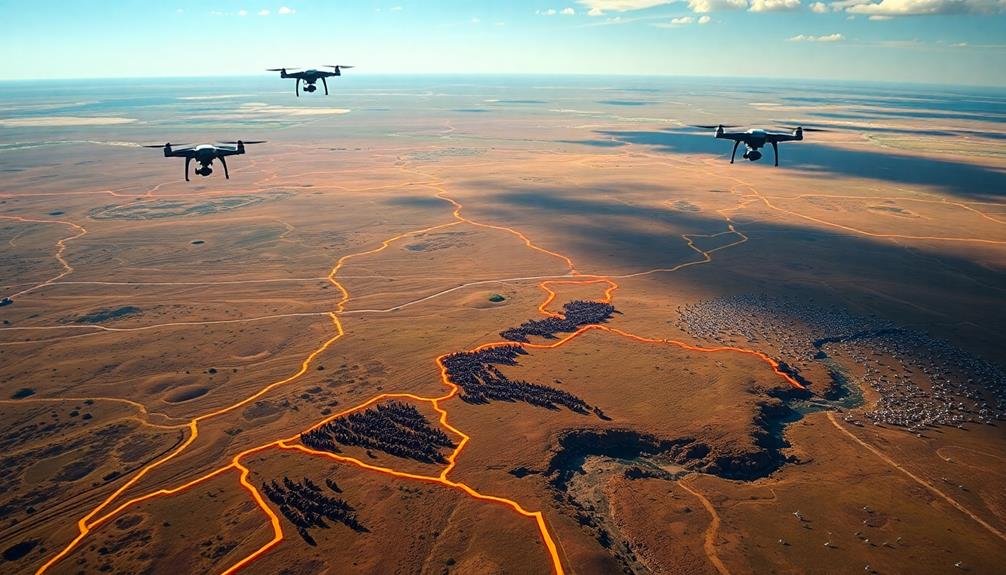
Aerial observation has revolutionized the study of animal migration patterns. You can now track large groups of animals across vast distances, gaining unprecedented insights into their movements. From planes and drones, you'll observe entire herds of wildebeest crossing the Serengeti or flocks of birds traversing continents.
With high-resolution cameras and GPS technology, you're able to map precise routes and identify key stopover points. This data helps you understand the challenges animals face during migration, such as habitat loss or climate change impacts. You'll spot previously unknown migration corridors and discover new breeding or feeding grounds.
Thermal imaging allows you to track nocturnal species or animals in dense forests. You can monitor sea turtle nesting sites along coastlines or follow whale pods across oceans. By combining aerial observations with satellite tracking, you'll create thorough migration models.
This bird's-eye view enables you to assess the effectiveness of conservation efforts and identify areas needing protection. You'll use this information to design wildlife corridors, plan conservation strategies, and influence policy decisions to safeguard migratory species and their habitats.
Conservation Success Stories Using Drones
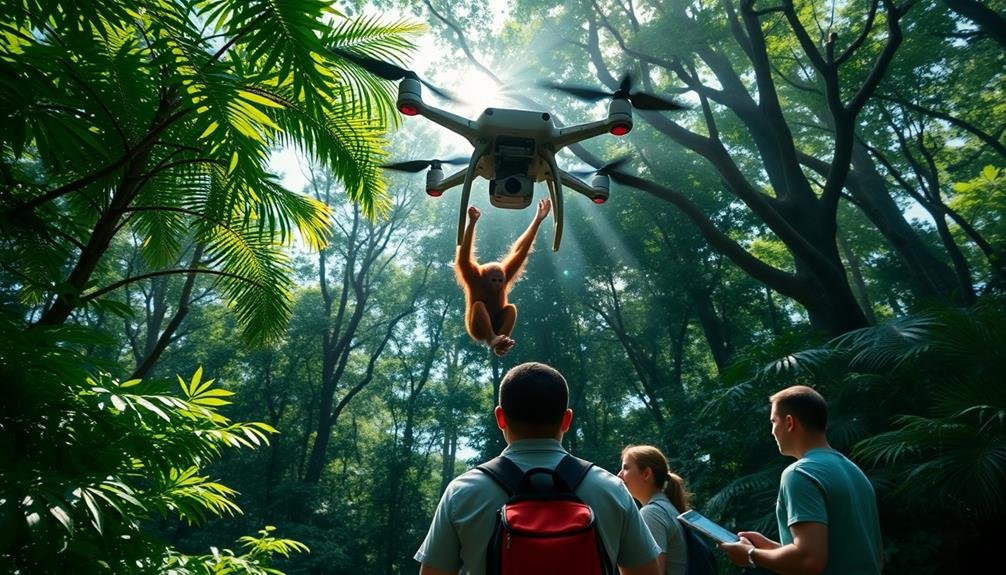
Soaring above diverse landscapes, drones have emerged as powerful tools in wildlife conservation efforts. You'll find these unmanned aerial vehicles revolutionizing how we protect endangered species and their habitats. Drones provide a non-invasive way to monitor wildlife populations, detect poaching activities, and assess ecosystem health.
In Africa, conservationists are using drones to combat rhino poaching. They're equipped with thermal cameras to spot poachers at night, allowing rangers to intervene quickly.
In the Amazon rainforest, drones are mapping deforestation and illegal logging activities, helping authorities take action against environmental crimes.
Drones have also proven invaluable in studying marine ecosystems. You'll see them being used to monitor coral reefs, track whale migrations, and even collect whale blow samples for health assessments.
The emotional impact of these conservation success stories is profound:
- Hope for endangered species' survival
- Empowerment of local communities in conservation efforts
- Awe at the beauty of untouched ecosystems seen from above
- Determination to protect our planet's biodiversity
As drone technology advances, you can expect even more innovative applications in wildlife conservation, offering new possibilities for protecting our natural world.
Challenges in Aerial Wildlife Observation
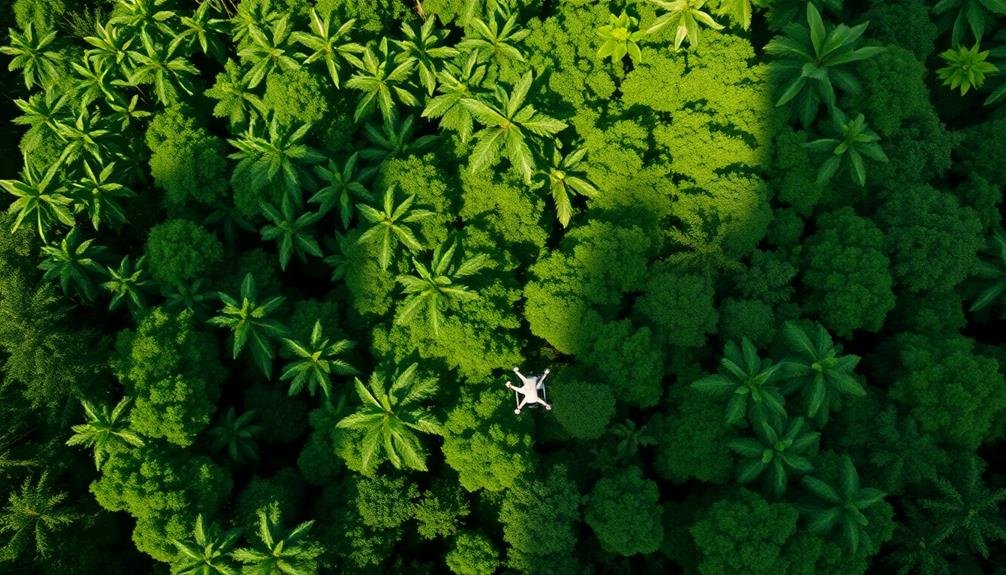
Despite their immense potential, drones face significant hurdles in wildlife observation. You'll encounter several challenges when using these aerial devices for monitoring animals in their natural habitats.
Firstly, you must navigate strict regulations governing drone usage in protected areas. Many wildlife reserves and national parks have restrictions or outright bans on drone flights, limiting your access to vital observation sites.
Weather conditions pose another obstacle. Wind, rain, and extreme temperatures can interfere with drone operations, affecting flight stability and image quality. You'll need to carefully plan your missions around ideal weather windows.
Battery life remains a constraint, limiting your observation time and range. This is particularly problematic when tracking migratory species or conducting long-term studies.
Noise pollution from drones can disturb wildlife, potentially altering their behavior and skewing your data. You'll need to find ways to minimize acoustic disturbance while maintaining effective observation distances.
Lastly, data processing and analysis present challenges. The sheer volume of imagery and video footage collected requires sophisticated software and expertise to interpret accurately, adding complexity to your research workflow.
Drone Regulations for Wildlife Research

When using drones for wildlife research, you'll need to navigate a complex web of permit requirements and restrictions.
You must familiarize yourself with local, state, and federal regulations governing drone use in wildlife areas.
Additionally, you'll need to adhere to ethical guidelines to minimize disturbance to animals and ecosystems while conducting your aerial observations.
Permit Requirements and Restrictions
Several key permit requirements and restrictions govern the use of drones for wildlife research. You'll need to obtain proper licensing from your country's aviation authority, such as the FAA in the United States. This often involves passing a knowledge test and registering your drone.
Additionally, you must secure permits from wildlife management agencies, which may include state and federal departments.
When operating drones for wildlife research, you're required to follow specific guidelines:
- Maintain a safe distance from animals to prevent disturbance
- Avoid flying during sensitive periods like breeding or nesting seasons
- Limit flight duration and frequency to minimize stress on wildlife
- Adhere to designated no-fly zones and protected areas
You'll also need to comply with general drone regulations, including maintaining visual line of sight, flying below maximum altitude limits, and avoiding restricted airspace.
Some areas may require special permissions or have temporal restrictions to protect certain species. It's essential to stay informed about local and seasonal regulations, as they can vary greatly depending on your research location and target species.
Ethical Considerations and Guidelines
Numerous ethical considerations come into play when using drones for wildlife research. You'll need to prioritize the well-being of animals and their habitats above your research goals. Always maintain a safe distance to avoid disturbing or stressing wildlife.
Be mindful of nesting sites, breeding grounds, and sensitive habitats that could be negatively impacted by drone presence. You should follow established guidelines, such as those provided by wildlife organizations and regulatory bodies.
These often include recommendations on flight altitudes, approach angles, and duration of observation. It's essential to minimize noise pollution and visual disturbance by using appropriate drone models and flying techniques.
You must also consider the broader ecological impact of your research. Confirm that your drone operations don't inadvertently harm other species or disrupt ecosystems.
Be transparent about your methods and share your findings responsibly to promote ethical practices within the scientific community. Lastly, respect privacy concerns and property rights when conducting aerial wildlife research.
Obtain necessary permissions and inform local communities about your activities to maintain positive relationships and support for conservation efforts.
Future of Drone-Based Conservation Efforts

As drone technology continues to advance, the future of conservation efforts looks increasingly promising. You'll see drones equipped with more sophisticated sensors, longer flight times, and improved AI capabilities. These enhancements will allow researchers to gather more detailed data on wildlife populations, habitats, and ecosystems.
In the coming years, you can expect drones to play an essential role in:
- Tracking migratory patterns of endangered species
- Monitoring the health of coral reefs and forests
- Detecting and preventing poaching activities
- Evaluating the impact of climate change on biodiversity
You'll witness the integration of drones with other technologies, such as satellite imagery and machine learning algorithms, to create more accurate predictive models for conservation strategies. This will enable you to make data-driven decisions and implement targeted interventions to protect vulnerable species and ecosystems.
As drones become more accessible and cost-effective, you'll see their adoption increase among conservation organizations worldwide. This widespread use will lead to a global network of drone-based monitoring systems, allowing for real-time data sharing and collaborative efforts to address pressing environmental challenges.
Ethical Considerations in Aerial Monitoring

While drone technology offers immense potential for wildlife conservation, it also raises important ethical questions. You'll need to take into account the impact of drones on animal behavior and stress levels. Flying too close or too frequently can disrupt natural patterns and potentially harm the very creatures you're trying to protect.
Privacy concerns also come into play. You must guarantee that your aerial monitoring doesn't inadvertently capture images of people or private property without consent. This is especially vital in areas where wildlife habitats overlap with human settlements.
Reflect on these key ethical considerations:
| Issue | Mitigation Strategy |
|---|---|
| Animal stress | Maintain safe distances |
| Habitat disruption | Limit flight frequency |
| Privacy invasion | Use geofencing technology |
| Data security | Implement encryption protocols |
You'll also need to address the potential misuse of data collected during aerial monitoring. Poachers or illegal traders could exploit this information if it falls into the wrong hands. Implement strict data security measures and carefully control access to sensitive information about wildlife locations and movements.
Frequently Asked Questions
How Much Does a Wildlife Observation Drone Typically Cost?
You'll find wildlife observation drones ranging from $300 to $5,000. Basic models start around $300-$500, while professional-grade drones with advanced features can cost $2,000-$5,000. Your specific needs will determine the best option for you.
Can Drones Be Used to Track Aquatic Animals Underwater?
You can use drones to track aquatic animals underwater, but they're limited. Specialized underwater drones are better suited for this task. They can dive deep, capture high-quality footage, and even follow marine life for extended periods.
What Training Is Required to Operate Drones for Wildlife Research?
You'll need training in drone piloting, wildlife behavior, and research protocols. You should learn about regulations, safety, and ethical considerations. You'll also require specialized skills in data collection, analysis, and interpretation for wildlife studies.
How Do Researchers Differentiate Between Individual Animals of the Same Species?
You'll find researchers use various techniques to differentiate individual animals. They'll look for unique markings, scars, or patterns. They'll also employ photo-identification software, GPS tracking, and DNA analysis to distinguish between animals of the same species.
Are There International Agreements for Using Drones in Cross-Border Wildlife Monitoring?
You'll find that international drone use for cross-border wildlife monitoring is often regulated by bilateral agreements. Countries may collaborate on shared conservation efforts, but you'll need to check specific regional protocols as they vary widely.
In Summary
You've seen how drones are revolutionizing wildlife observation from above. They're offering unparalleled advantages in monitoring and conservation efforts. As technology advances, you'll witness even more sophisticated applications, from AI-powered identification to thermal imaging. Remember, while these tools are powerful, you must consider ethical implications and follow regulations. The future of wildlife research is in your hands, and it's looking skyward. Embrace this aerial revolution responsibly.

As educators and advocates for responsible drone use, we’re committed to sharing our knowledge and expertise with aspiring aerial photographers.




Leave a Reply